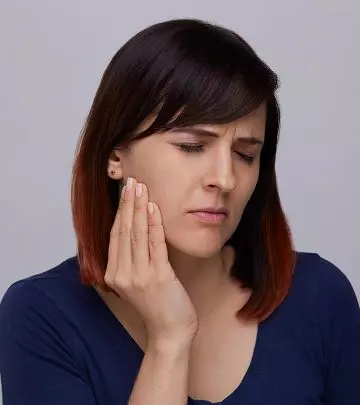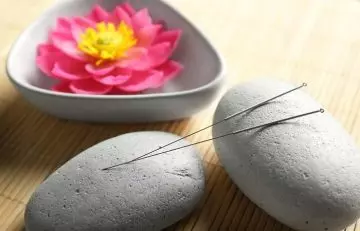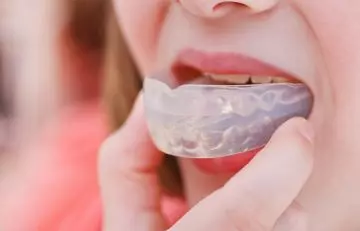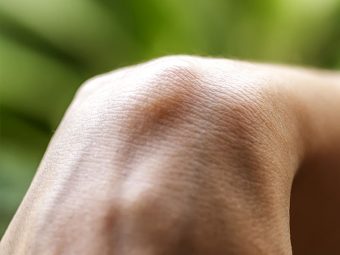10 Effective Home Remedies For TMJ Pain And Exercises For It

Image: Shutterstock
TMJ muscles or temporomandibular joints are your jaw joints and muscles that swing into action every time you chew or talk. Around 10 to 36 million people in the US experience TMJ disorders (1). A few exercises and home remedies for TMJ pain can effectively manage the soreness and discomfort. When you experience pain in those muscles, it could be from chewing too much or a sign of an underlying medical issue like arthritis. The good news is that there are a few natural ways to relieve TMJ pain effectively. In this article, we look at some of the causes and symptoms of TMJ pain and the ten best ways to treat them at home. Read on to find out!
In This Article
What Is The TMJ Joint?
The TMJ or temporomandibular joint is located at the base of the skull, and its main function is to allow movement that is required for talking and chewing.
The lower part of the jaw, called the mandible, is connected to the temporal bones on the sides of the skull with the help of the TMJ joint. This joint is one of the most complex joints in your body as it allows movement of the jaw from side to side as well as up and down.
When the TMJ is affected, it leads to disorders that can cause great pain and discomfort.
What Are TMJ Disorders?
TMJ disorders are most often a result of an injury or damage to the temporomandibular joint that connects your jaw to the skull. These disorders include a broad category of conditions affecting the TMJ and have many possible causes. They are usually characterized by pain in the jaw as well as the muscles that control the movement of your jaw. This pain is usually more prominent when you chew, click, crackle, or pop your jaw.
The symptoms associated with these disorders can vary in terms of their nature and severity.
Symptoms Of TMJ Pain
The symptoms of TMJ may include:
- Pain while moving the jaw
- Headaches or migraines
- Neck, back, or ear aches
- A grinding, clicking, or popping sound from the jaw while moving it
- A buzzing or ringing sound in the ears
- Limited jaw movement due to locking of the joint
- Facial pain
The severity of these symptoms may vary from one person to another.
The exact cause of TMJ pain is difficult to determine. However, here are some factors that may be responsible for causing the pain.
What Causes TMJ Pain?
The causes of TMJ pain may include:
- Infections
- Misalignment of the teeth/jaw
- Autoimmune disorders
- An injury to the jaw
- Damage of the TMJ due to medical conditions like arthritis
The following are some factors that can increase your risk of developing TMJ pain.
Risk Factors
The risk factors for TMJ pain are:
- Teeth grinding
- A history of dental surgery
- Stress that causes your facial and/or jaw muscles to tighten
- Poor posture
- Chewing gums excessively
- Use of orthodontic braces
- Genetic predisposition to pain and sensitivity
The pain and discomfort associated with TMJ disorders are usually temporary and can be relieved easily. Self-management is one of the best ways to treat mild to moderate cases of TMJ pain. Listed below are some of the best ways that can help you manage TMJ pain on your own.
Best Ways To Relieve TMJ Pain
1. Hot Or Cold Compress
You Will Need
A hot or cold compress
What You Have To Do
- Apply a hot or cold compress to your jaw.
- Place it there for 5-10 minutes.
- Remove and repeat a couple of times.
How Often You Should Do This
You can apply this 2-3 times daily to the affected area.
Why This Works
Both hot and cold therapies can help alleviate musculoskeletal pain. Hot therapy improves circulation, whereas, cold therapy numbs the pain and can help reduce inflammation and swelling (2).
2. Acupuncture
Acupuncture is a form of alternative medicine that is quite commonly used to relieve pain. It involves the insertion of multiple acupuncture needles at specific acupuncture points. According to a study published in the journal Medicine, acupuncture was able to reduce symptoms of myofascial pain in patients with TMD (3). Hence, you can try and avail this therapy from a professional to relieve symptoms of TMJ pain.
3. CBD Oil
You Will Need
1-2 drops of CBD or cannabidiol oil
What You Have To Do
- Take one to two drops of CBD oil and apply a thin layer on the affected area.
- Allow the oil to be absorbed into your skin.
Note: Consult a doctor for proper guidance before using this remedy.
How Often You Should Do This
You may do this 1-2 times daily.
Why This Works
CBD oil can attenuate symptoms of early-phase inflammation and may be a great option for those experiencing TMJ pain (4).
4. Essential Oils
a. Lavender Oil
You Will Need
- 1-2 drops of lavender oil
- 1-2 teaspoons of coconut oil or any other carrier oil
What You Have To Do
- Add one to two drops of lavender oil to one to two teaspoons of any carrier oil.
- Mix well and apply the blend to the affected area.
- Leave it on for 20-30 minutes and rinse it off with water.
- You may also leave it on and wait for it to dry naturally.
- Alternatively, you can also inhale the pleasant aroma of the oil using a diffuser.
How Often You Should Do This
You may do this 1-2 times daily.
Why This Works
The analgesic and anti-inflammatory properties of lavender oil can help in reducing TMJ pain (5).
b. Eucalyptus Oil
You Will Need
- 1-2 drops of eucalyptus oil
- 1-2 teaspoons of coconut oil or any other carrier oil
What You Have To Do
- Add one to two drops of eucalyptus oil to one to two teaspoons of coconut oil or any other carrier oil.
- Mix well and apply it to the affected area.
- Leave it on until it dries on its own.
How Often You Should Do This
You can do this two times daily for best results.
Why This Works
Like lavender oil, eucalyptus oil also has analgesic and anti-inflammatory properties that may be beneficial in the treatment of TMJ pain (6).
5. Oil Pulling
You Will Need
1 tablespoon of cold-pressed coconut oil
What You Have To Do
- Swish cold-pressed coconut oil in your mouth
- for 10 minutes and spit it out.
- Go about your regular oral regimen, like brushing and flossing.
How Often You Should Do This
Do this once daily, preferably every morning.
Why This Works
The anti-inflammatory and analgesic properties exhibited by coconut oil can help alleviate symptoms of pain and inflammation associated with TMD (7).
6. Mouthguard
The use of a mouth guard or oral splint is a conservative approach for treating TMJ pain. It can help reduce the symptoms without changing the alignment of your jaw or teeth (8).
In addition to these remedies, here are some great exercises that can help reduce TMJ pain.
Exercises For TMJ Pain Relief
- Relaxed Jaw Exercise
- Goldfish Exercise (Partial Opening)
- Goldfish Exercise (Full Opening)
- Chin Tucks
- Resisted Opening Of The Mouth
- Resisted Closing Of The Mouth
- Tongue-To-Roof
- The Side Slide
- Forward Jaw Movement
- Wide Stretch
- Mandibular Stabilization Exercises
- Occipital Lifts
To know how to do these exercises.
TMJ or temporomandibular joints refer to the joints and muscles in the jaw that help with actions like chewing and talking. An injury or damage to this joint can lead to TMJ disorders. Pain in the jaw or the muscles that connect the jaw to the skull, headaches, pain in the neck, back, or ears, buzzing sound in the ears, facial pain, and limited jaw movement are some common signs and symptoms of issues with the temporomandibular joints that may be caused due to infections, external injury, misalignment, certain medical conditions, and autoimmune disorders. However, the pain and discomfort may be alleviated with effective home remedies for TMJ pain like hot compress, acupuncture, CBD oil, essential oils, and certain exercises that help in strengthening your jaw muscles. You may need to opt for medical attention and surgical procedures in severe cases.
Frequently Asked Questions
How long does TMJ pain last?
TMJ pain usually lasts anywhere between a few days to a few weeks. If the pain has turned chronic, it is best to see a doctor immediately.
When to see a doctor for TMJ pain?
If you have persistent pain or tenderness in the jaw, consult a doctor immediately. Constant clicking, popping, or grinding sounds when you open or close your mouth may also require medical intervention.
How do you relax your jaw before bed?
If you are used to clenching your jaw, the symptoms of TMJ pain can worsen. Hence, it is necessary that you learn how to relax your jaw, especially before bed. Positioning your tongue between your teeth or holding a warm cloth against your cheek, right next to your earlobes, can help in relaxing your jaw muscles.
What helps jaw pain from clenching teeth?
Massaging your jaw, trying out aromatherapy or hot/cold compress, and using a mouth guard can help relieve jaw pain that results from clenching your teeth.
Do ENT doctors treat TMJ?
Yes, ENT doctors can help with the symptoms of TMJ pain.
References
- “Temporomandibular Disorders and Associated Clinical Comorbidities” SemanticScholar.
- “Mechanisms and efficacy of heat and cold therapies for musculoskeletal injury.” Postgraduate Medicine, US National Library Of Medicine.
- “Acupuncture therapy in the management of the clinical outcomes for temporomandibular disorders” Medicine, US National Library Of Medicine.
- “Transdermal cannabidiol reduces inflammation and pain-related behaviours in a rat model of arthritis” European Journal of Pain, US National Library Of Medicine.
- “Antioxidant, analgesic and anti-inflammatory effects of lavender essential oil.” Annals of the Brazilian Academy of Sciences, US National Library Of Medicine.
- “Analgesic and anti-inflammatory effects of essential oils of Eucalyptus.” Journal of Ethnopharmacology, US National Library Of Medicine.
- “Anti-inflammatory, analgesic, and antipyretic activities of virgin coconut oil.” Pharmaceutical Biology, US National Library Of Medicine.
- “Oral splint for temporomandibular joint disorders with revolutionary fluid system” Dental Research Journal, US National Library Of Medicine.



















